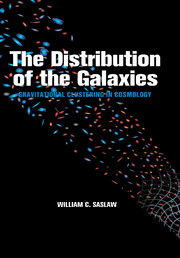Book contents
- Frontmatter
- Contents
- Prologue
- Part I Historical
- Part II Descriptions of Clustering
- Part III Gravity and Correlation Functions
- Part IV Gravity and Distribution Functions
- Part V Computer Experiments for Distribution Functions
- Part VI Observations of Distribution Functions
- 33 Observed Spatial Distribution Functions
- 34 Observed Peculiar Velocity Distribution Functions
- 35 Observed Evolution of Distribution Functions
- Part VII Future Unfoldings
- Bibliography
- Index
33 - Observed Spatial Distribution Functions
Published online by Cambridge University Press: 19 January 2010
- Frontmatter
- Contents
- Prologue
- Part I Historical
- Part II Descriptions of Clustering
- Part III Gravity and Correlation Functions
- Part IV Gravity and Distribution Functions
- Part V Computer Experiments for Distribution Functions
- Part VI Observations of Distribution Functions
- 33 Observed Spatial Distribution Functions
- 34 Observed Peculiar Velocity Distribution Functions
- 35 Observed Evolution of Distribution Functions
- Part VII Future Unfoldings
- Bibliography
- Index
Summary
He had bought a large map representing the sea
Without the least vestige of land:
And the crew were much pleased when they found it to be
A map they could all understand.
Lewis CarrollBasic Questions
Early analyses (e.g., Gregory and Thompson, 1978; Kirshner et al., 1981; Fairall et al., 1990; Fairall, 1998) of modern magnitude-limited galaxy catalogs revealed large empty regions, originally called voids. These regions filled in somewhat as more sensitive surveys found fainter galaxies (e.g., Kirshner et al., 1987), but they remained underpopulated. Cosmological many-body simulations gave a probability f0(V) for finding such empty regions (Aarseth and Saslaw, 1982), even before their theoretical distribution function was calculated. Soon it became clear that these voids and underdense regions were part of a more general distribution function description.
In retrospect, we may regard many analyses of observed spatial distribution functions as attempts to answer several basic questions. Although these questions are not yet fully answered, and relations among them are not always apparent, we will use them to guide our discussion here.
Is the observed form of f(N, V) generally consistent with gravitational quasiequilibrium clustering? If so, does it rule out other possibilities such as particular dark matter distributions or initial conditions?
Do the two-dimensional distribution functions for projections onto the sky give a good estimate of f(N, V) or do we need the full three-dimensional distribution function?
How does b(r) depend on spatial scale? Can this dependence restrict possible models significantly?
[…]
- Type
- Chapter
- Information
- The Distribution of the GalaxiesGravitational Clustering in Cosmology, pp. 429 - 451Publisher: Cambridge University PressPrint publication year: 1999



